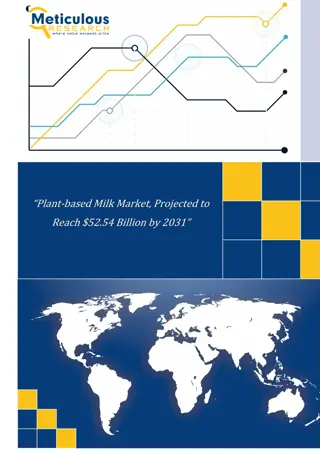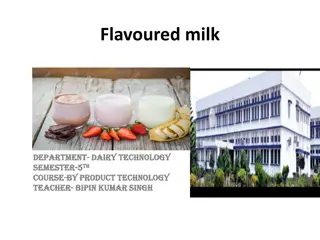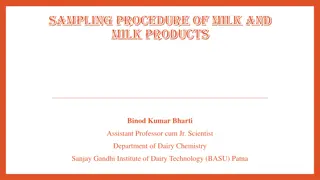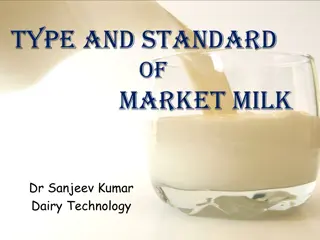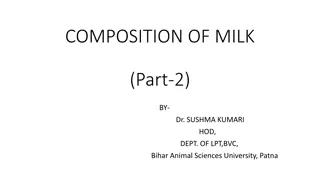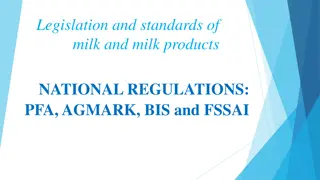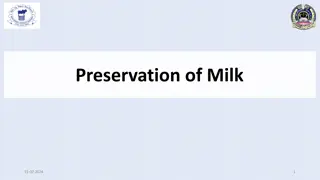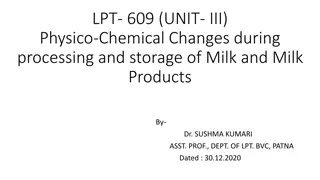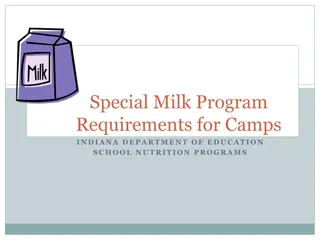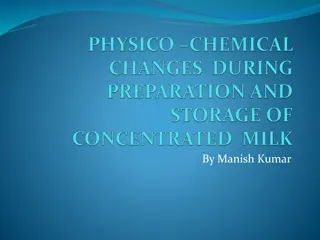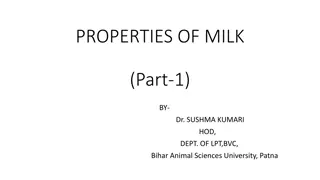Evolution of Milk Industry: India & Abroad
Explore the historical journey of the market milk industry in India and abroad, covering topics such as dairy development, establishment of milk plants, and the impact of Operation Flood. Learn about the transformation from traditional milk handling to organized distribution, highlighting key milestones and challenges faced in the industry.
Download Presentation

Please find below an Image/Link to download the presentation.
The content on the website is provided AS IS for your information and personal use only. It may not be sold, licensed, or shared on other websites without obtaining consent from the author.If you encounter any issues during the download, it is possible that the publisher has removed the file from their server.
You are allowed to download the files provided on this website for personal or commercial use, subject to the condition that they are used lawfully. All files are the property of their respective owners.
The content on the website is provided AS IS for your information and personal use only. It may not be sold, licensed, or shared on other websites without obtaining consent from the author.
E N D
Presentation Transcript
Market Milk Industry in India & Abroad Dr Sanjeev Kumar Associate Professor Dairy Technology, SGIDT,Patna (BASU, Patna)
Market Milk Industry in India Market Milk Industry in India Topics Covered: Beginning of organised Milk Handling in India Dairy Development in India Before & After Operation Flood Present status of the Market Milk Industry in India India s Position in relation to some of the important milk producing countries of the world
Salient features of the market milk industry Handling of milk in Co-operative Milk Union (Oldest: Allahabad, 1913) established all over the country on a small scale in the early stages. Long distance refrigerated rail-transport of milk from Anand to Bombay since 1945. Pasteurization and bottling of milk on a large scale for organized distribution was started at Aarey (1950), Worli (1961), Calcutta (Haringhata, 1959), Delhi (1959), Madras (1963), etc.
Conti----- Establishment of Milk Plants under the Five-Year Plans for Dairy Development all over India. Dual object of increasing the national level of milk consumption and ensuring better returns to the primary milk producer The main aim ---- to produce mere, better and cheaper milk.
Dairy Development in India Before Operation Flood British Rule established military dairy farms to ensure the supply of milk and butter to the colonial army. The first of farms ---- set up in Allahabad in 1913, followed by Bangalore, Ooty and Karnal. Artificial Insemination --- Dairy farms.
Conti----- With the growth of the population in urban areas, consumers --- to depend on milk vendors who kept cattle in these areas and sold their milk, often door-to-door. As a result, several cattle sheds came into existence in different cities, which led to environmental problems. As the main objective of the milk vendors ----- to maximize profit,. Consequently, these high yielding cattle developed sterility problems, which considerably reduced the number of calving. Once the cattle became unproductive, they ---- sold to slaughter houses, thus systematically draining the country of its genetically superior breeds.
Conti----- The onset of the Second World war ---- momentum to private dairies with some modernized processing facilities. In the metros of the then Bombay, Calcutta, Madras and Delhi, and some large towns, processed milk, table butter and ice- cream were available, though on a limited scale. Polsons, Keventers and the Express Dairy ---- some of the pioneer urban processing dairies. However, these dairies ----- more concerned with cornering more milk and profit making than improving the breeds of Milch animals. Therefore, despite some modernized processing facilities, dairying remained unorganized.
Conti----- Modernization of the dairy industry became a priority for the government after first Five-Year Plan in 1951 and it was put in place. The goal ----- to provide hygienic milk to the country's growing urban population. At the outset, milk schemes were set up in large cities. The government implemented programmes such as the Integrated Cattle Development Project (ICDP), Key Village Scheme (KVS) and several others to stimulate milk production. However, milk production remained more or less stagnant owing to the absence of a stable and remunerative market for milk producers.
Conti----- During the two decades between 1951 and 1970, the annual growth rate in milk production ---- just about 1% although the state governments tried out different policies to develop dairying. These strategies included establishing dairies run by their own departments, setting up cattle colonies in urban areas and organizing milk schemes. These government projects found organizing rural milk procurement and running milk schemes economically extremely difficult. No attention was paid to create an organized system for procurement of milk, which was left to contractors and middlemen.
After Operation Flood Strategy for organized dairy development in India ---- actually conceived in the late 1960s, within a few years after the establishment of National Dairy Development Board (NDDB) in 1965. NDDB ----- established by an Act of Parliament with the objectives of promoting dairy cooperatives, financing dairy infrastructure through loans and grants and providing technical and managerial support to the dairy cooperative societies. The Operation Flood programme (OFP) ---- conceived by the NDDB and endorsed by the government. However, in 1969, when the Government of India approved the OFP and its financing through the monetization of World Food Programme-gifted commodities, The statutes under which NDDB was registered did not provide for handling of government funds.
Conti----- Therefore, in 1970 the government established a public-sector company, the Indian Dairy Corporation (IDC). The IDC ----- given responsibility for receiving the project's donated commodities, testing their quality, their storage and transfer to user dairies as well as receiving the dairies' payments. Thus the financial and promotional aspects ----- the responsibility of the IDC while the entire technical support for OFP was provided by NDDB.
Conti----- OFP ---- set up with the objectives to enhance milk production, increase the rural income and to ensure reasonable price to the farmers for the milk they produce. OFP ---- implemented in three phases. The first phase (1970-1980) --- financed by the sale of 1,26,000 MT of skimmed milk powder (SMP) and 42,000 MT of butter oil gifted by the European Union (then European Economic Community EEC) through the World Food Programme. India currently has 133349 village dairy cooperatives federated into 177 milk unions and 15 federations that procured on an average 25.1 million litres of milk every day. Village dairy cooperatives have nearly 14.11 million farmers as members (www.nddb.org).
Present Status of the Market Milk industry in India India ranks first in respect of cattle and buffalo, second in goat and third in sheep population in the world. India has more than 175 million cattle ---- about 13% of the global cattle population (www.fao.org). However, in spite of this large cattle wealth and India s position as the highest producer of milk, productivity per animal is only 987 kg/lactation as compared to the world average of 2038 kg/lactation (www.dahd.nic.in). In the advanced dairying countries, milk is produced from comparatively fewer, but high producing animals. In countries such as Denmark and Israel, though the total number of bovine population has steadily declined over the past decade, the total milk production has gone up, thus pointing to increased productivity of animals.
Conti----- Main reasons for this acute shortage of milk low milk-yielding capacity of the average Indian cow acute shortage of feeds and fodder. Lack of organized milk production and collection, restricted transport facilities (especially refrigerated) and shortage of processing and marketing organizations have greatly hampered the growth of the market milk industry. Poor-quality milk, wide-spread adulteration, and lack of quality consciousness among the great majority of consumers --- further aggravated the situation.
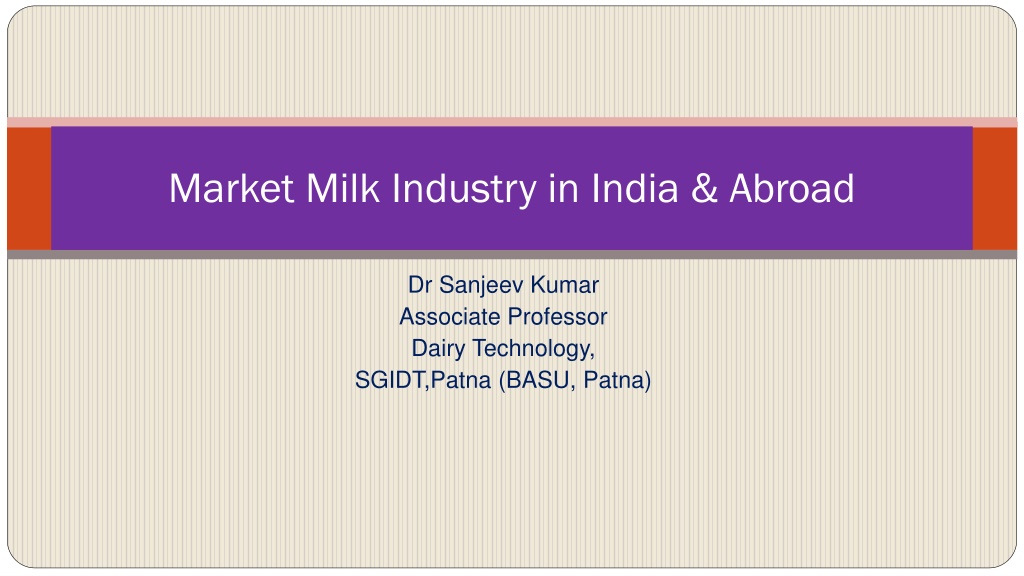
 undefined
undefined














